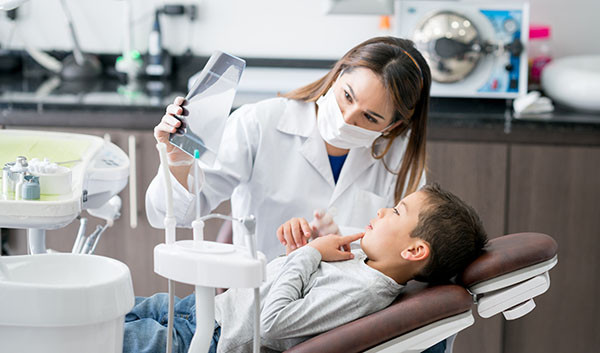Making visits to the dentist easier for people with autism spectrum disorder

Autism spectrum disorder (ASD) is a common developmental disorder characterized by difficulty with social communication and restricted or repetitive patterns of thought and behaviors. About 1 in 54 children is diagnosed with ASD. People with ASD have communication challenges, and may have certain behavioral characteristics, such as difficulty with changes in routine and in new/unfamiliar places or sensory processing differences, that make preventative dental care and dental evaluations particularly difficult. Some research shows that children with autism have a higher risk of dental disease.
First, focus on prevention and home dental hygiene routines
People with ASD may have difficulty engaging in healthy dental hygiene habits, like brushing and flossing, due to sensory sensitivities. Some may have certain habits, like grinding their teeth, tapping or hitting their mouth and teeth, chewing nonfood objects, or eating sugary foods, that can also affect their dental health. Additionally, it may be difficult for some with ASD to communicate problems with their teeth, resulting in delays in care.
Establishing a routine with oral care at a young age is recommended. Brushing should begin as soon as the first tooth comes in, using a small smear of fluoride-containing toothpaste. If the child has taste or texture sensitivity, parents can experiment with different flavors, or unflavored or nonfoaming toothpastes (sodium lauryl sulfate–free). There are many choices for toothbrushes, such as a spinning or battery-powered toothbrush for children who like vibration.
Combine brushing with other daily routines or with a preferred activity, such as bathing. Laying the child on a soft carpet or bed with a visual distraction, such as a book or mirror, can allow the parent easier access to the teeth and provide additional comfort.
As a child gets older, parents can use a hand-over-hand method, and then turn-taking: to help the child build independent brushing skills, parents can encourage their child to brush first, and then take a "parent turn." Incorporating toothbrushing practice with a speech language therapist, occupational therapist, or behavior analysis therapist can also be helpful.
For many people with ASD, a trip to the dental clinic can be a challenge
Dental clinics often have bright fluorescent lights, loud noises from people and equipment, and unfamiliar procedures. Dental visits and procedures can be especially difficult for children with ASD who have hypersensitivity to strong smells, tastes, and textures, or who do not tolerate people or objects near their face and mouth. Some dental practices may have limited experience or training working with children with special needs, and may be reluctant to treat those with ASD.
Fortunately, there are many tips and strategies that can help people with ASD to develop healthy habits and have a positive experience with dental care.
Tips for making dental visits successful
- Establishing a dental home with an experienced and accommodating pediatric dental team by a child's first birthday can start a child on the road to a lifetime of good oral health. The added benefit of early visits is that they are quick and pain-free, and help to establish trust with the dental team and familiarity with the dental environment.
- Call ahead of the visit to discuss your child's specific needs and preferences. Things that may help include noise-canceling headphones, listening to music, a weighted blanket or vest, sunglasses, turning off fluorescent ceiling lights, limited talking during the dental procedure, or watching a favorite video. Giving your child a hand mirror to watch may be helpful. Panoramic x-rays, which are fast and don't involve putting items in a child's mouth, may be better tolerated than conventional intraoral dental x-rays. A parent or caregiver can be draped and stay in the room to provide head support during the exposure of the x-ray. Some children like being wrapped in a papoose, while others do not.
- Provide visual supports and first/then statements, such as, "First I count your teeth, then you go home." Social stories and video models can help children with ASD understand the expectations and follow along with the steps.
- Incorporate positive reinforcement throughout the dental visit, and reward for success after completion of each step, or at the end of the visit. (It is best to offer rewards that are not sticky, sweet foods.)
- Some children with ASD may benefit from a gradual introduction to each step over multiple successive visits, rather than trying to restrain the child in an effort to accomplish everything at once. Some dental clinics may also offer desensitization visits to prepare for a cleaning or procedure.
Anxiety-relieving medications can help
Working with the medical care team to develop a successful plan for anxiety reduction is an important part of the overall care for a person with ASD. Even with accommodations and adjustments, some children and adolescents with ASD may still struggle with dental evaluations or procedures. Anxiety-relieving medications or light sedation can be used prior to the dental visit to help them overcome their anxiety. Some specialized centers may offer exams and dental treatment under general anesthesia when needed.
About the Authors

Isabelle Chase, DDS, FRCD(C), Contributor

Nicole Baumer, MD, MEd, Contributor
Disclaimer:
As a service to our readers, Harvard Health Publishing provides access to our library of archived content. Please note the date of last review or update on all articles.
No content on this site, regardless of date, should ever be used as a substitute for direct medical advice from your doctor or other qualified clinician.















